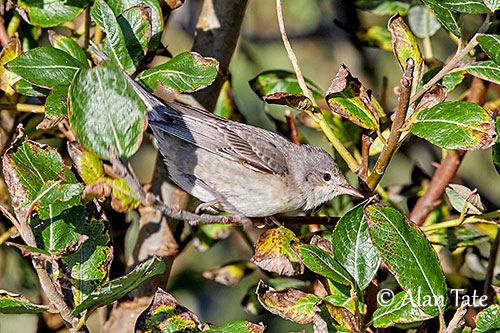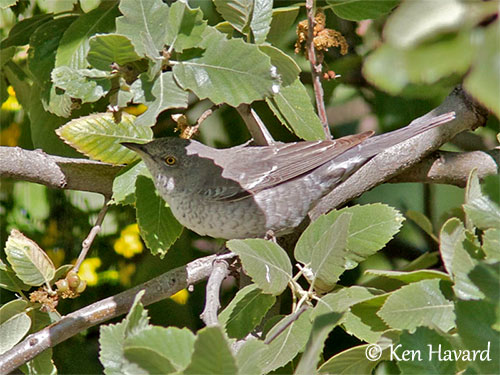
Fr: Fauvette épervière
Ang: Barred Warbler
All: Sperbergrasmücke
Esp: Curruca Gavilana
Ita: Bigia padovana
Nd: Sperwergrasmus
Sd: höksångare
Photographers:
John Anderson
John Anderson Photo Galleries
Didier Buysse
Vision d’Oiseaux
Ken Havard
My Bird Gallery & Flickr gallery 1 & Flickr gallery 2
William Price
PBase-tereksandpiper & Flickr William Price
Alan & Ann Tate
AA Bird Photography
Ingo Waschkies
Bird Photography
Text by Nicole Bouglouan
Sources:
HANDBOOK OF THE BIRDS OF THE WORLD Vol 11 by Josep del Hoyo, Andrew Elliott and David Christie - Lynx Edicions - ISBN: 849655306X
THE HANDBOOK OF BIRD IDENTIFICATION FOR EUROPE AND THE WESTERN PALEARCTIC by Mark Beaman, Steve Madge - C. Helm - ISBN: 0713639601
BIRDS OF THE MIDDLE EAST by R.F. Porter, S. Christensen, P Schiermacker-Ansen C.Helm - ISBN: 0713670169
Warblers of Europe, Asia and North Africa De Kevin Baker – Editeur: Bloomsbury Publishing, 2010 – ISBN: 1408135213, 9781408135211 – 360 pages
Sylvia Warblers: Identification, taxonomy and phylogeny of the genus Sylvia De Andreas Helbig, Gabriel Gargallo, Hadoram Shirihai – Editeur: A& C Black, 2010 – ISBN: 1408135094, 9781408135099 – 576 pages
Kazakhstan Birdwatching Community
What Bird-The ultimate Bird Guide (Mitchell Waite)
Wikipedia, the free encyclopaedia
Barred Warbler
Curruca nisoria
Passeriformes Order – Sylviidae Family
INTRODUCTION:
The Barred Warbler is a large Old World warbler found in temperate regions of Central and Eastern Europe and Central Asia during the breeding season. This species is strongly migratory and spends the winter in tropical E Africa. Two subspecies share the large range.
The Barred Warbler is the largest member of the genus Curruca. It frequents patches of open woodland with thorny bushes, hedgerows and low trees, and with grassy vegetation at the edges. It is able to frequent a large variety of habitat types, but with bushes, trees, clearings with undergrowth, pastures, meadows and orchards.
It feeds primarily on insects during the breeding season, but a frugivorous diet including berries and other fruits is important prior to migration and at stop-over sites. The migration is strictly nocturnal.
The mating system of the Barred Warbler is complex and includes both monogamy and polygamy. The males may pair with two or three females. The immatures may sometimes become helpers at nest. The open-cup-shaped structure is built by both adults. This species lays a single brood per season.
Both hard look and barred breast of the Barred Warbler make it quite similar to the Eurasian Sparrowhawk, which wisely gave it its French name.
The Barred Warbler is threatened by habitat loss caused by intensification of agriculture. However, the species is described a locally common and widespread. The population is not globally threatened at the moment.

DESCRIPTION OF THE BIRD:
Biometrics:
Length: 15-17 cm
Wingspan: 24-25 cm
Weight: M: 20-25 g – F: 21-29 g
The Barred Warbler adult male of nominate race has medium-grey to brownish-grey upperparts with sometimes a bluish wash. The feather tips show white fringes bordered by dark, subterminal bands, forming scaled pattern.
On the upperwing, both median and greater coverts have pale tips, forming a double wingbar. The tertials show broad, whitish fringes. The tail is darker. The outermost rectrices show white edges and tips.
On the whitish underparts, the body sides are washed buffish-cream. Chin and throat show grey barring whereas breast and flanks have coarser grey bars. Belly and vent are barred with short, narrow, grey bars. On the undertail-coverts, we can see dark grey subterminal chevrons forming conspicuous scaled pattern.
On the head, crown and ear-coverts are slightly darker that the upperparts. Lores and ear-coverts are speckled white. Chin and throat are whitish with grey bars.
The bill is dark grey with pale base on lower mandible. The eyes are deep yellow. Legs and feet are dark grey, becoming sometimes yellower in spring.
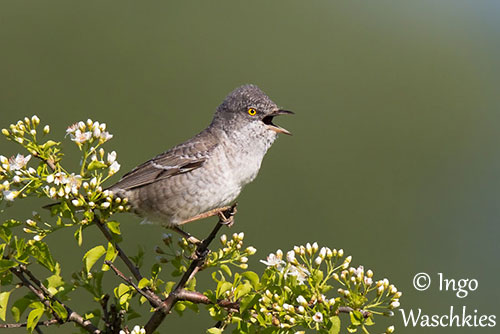
The female resembles male but she differs by brownish upperparts, often more uniformly coloured. The underparts are whiter and less heavily barred. The white tips in wings and on tail edges are smaller. The eyes are usually paler yellow.
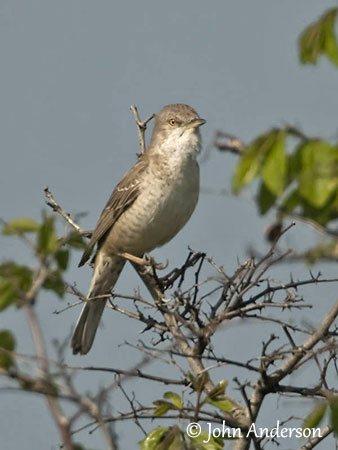
The juvenile has brownish-grey upperparts with ochraceous tinge and buffish fringes on wing-coverts. The underparts are ochraceous-buff without any barring. The eyes are dark brown.
The 1st winter is slightly scalloped on the underparts.
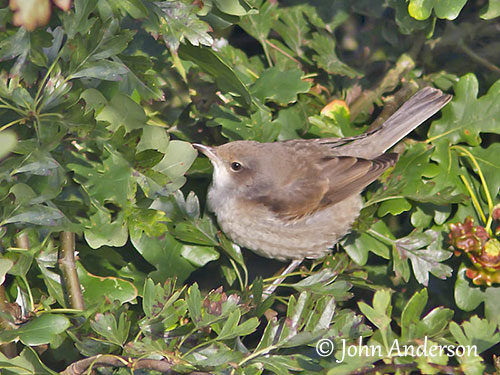
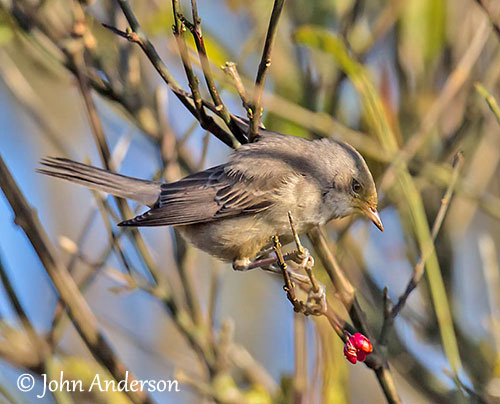
SUBSPECIES AND RANGE:
The Barred Warbler has two subspecies.
C.n. nisoria (described above) breeds in C Europe, E to S Ural Mts and R. Ural, S to N Italy, Balkans, N Turkey and N Iran. It winters in E Africa.
C.n. merzbacheri breeds in SW Siberia and N Kazakhstan E to Mongolia, and S locally in C Asian mountains to N Afghanistan and W China. It also winters in E Africa.
This race has paler upperparts, more brownish-sandy than nominate. The underparts are whiter and less barred. It appears less heavily patterned.
Across the wide area of intergradation, the single birds are often inseparable, especially in heavily worn plumage.
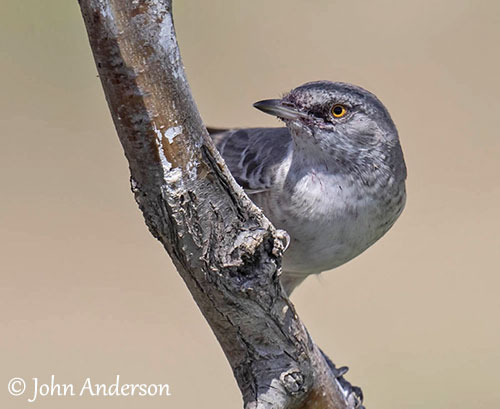
C.n. merzbacheri
Kazakhstan
HABITAT:
The Barred Warbler frequents patches of open woodland containing thorny bushes, hedgerows, low trees of various heights, and with grassy vegetation at the edges.
The bird uses bushes up to 3 metres high as song posts in open land. It may occur in dry habitats, sometimes on steep rocky slopes, but also in moister habitats such as wet meadows, moors, heather areas where bushes are available.
During the winter in Africa, the Barred Warbler is found in dry Acacia woodland, open gallery forest, riparian thickets and wooded savannas.
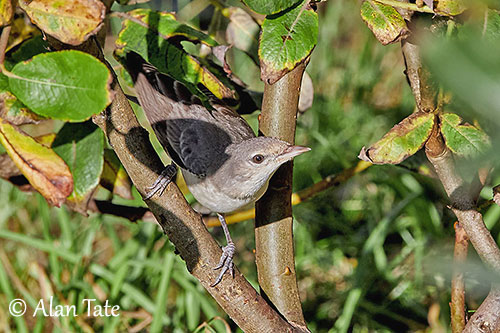
CALLS AND SONGS: SOUNDS BY XENO-CANTO
The Barred Warbler’s calls include a sharp “tak” and a short “churr” or “trrrrt”, sometimes extending into a rattling “trrrrt-t-t-t-t-t” when the bird is excited.
The alarm calls are harsher with metallic notes interspersed with rattle calls, and the bird gives also “tek” notes.
The song resembles that of the Garden Warbler, but with shorter phrases. It is a musical and vigorous warble made of variable short phrases and rattling.
The song is usually given from treetop or bush, or during a wing-clapping flight.
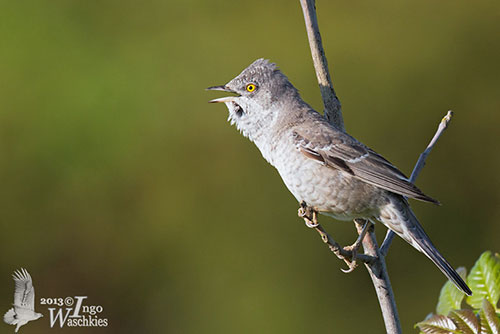
BEHAVIOUR IN THE WILD:
The Barred Warbler is primarily an insect-eater during the breeding season. The insect diet includes beetles (Coleoptera), small aphids, Lepidoptera larvae, small grasshoppers and also spiders. The chicks are mainly fed soft-bodied prey, especially caterpillars.
After the breeding period and especially prior to migration, the bird feeds on berries and other fruits.
The Barred Warbler forages mainly in bush near the ground, or in canopy of small trees. It gleans prey from branches and foliage while perched. It rarely performs sallies for flying insects, and comes very occasionally to the ground, except when feeding the nestlings.
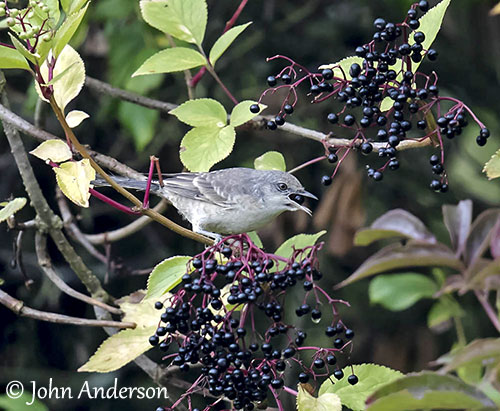
The Barred Warbler is territorial during the breeding season, although territories are often grouped in very suitable habitat. Some males are monogamous, but most of them become polygamous within the breeding season. Once the first female is incubating, they establish one or more new territories in order to attract other females.
If the polygamous pairs are successful, most secondary females perform alone the nesting duties. The male usually feeds the chicks of one brood, often the first one, but rarely more.
The male performs aerial displays such as steeply-rising song flights initiated from perches and rising up to 3-10 metres above this perch. This flight display is relatively slow and with high amplitude wingbeats while the tail is spread (the white corners are visible).
In front of rival male during the highest intensity of the flight, the bird may clap the wings together above its back, producing an audible clapping noise.
They are solitary outside of breeding season.
The presence of predators may affect the choice of the nesting habitats. Some individuals reduce this risk by nesting near other species which have an aggressive nest defence.
Several observations describe the Barred Warbler and the Red-backed Shrike nesting together, especially in C and E Europe, and inhabiting similar environments. Each species strongly defends the nest and is aggressive towards predators. The main predators are birds and, to a lesser extent, also mammals.
These observations show that the survival rates of nests are higher in territories of individuals breeding close to each other in protective nesting association. However, some researchers suggest that this is the result of similar habitat preferences and that relations between these two species are neutral. More studies are needed.
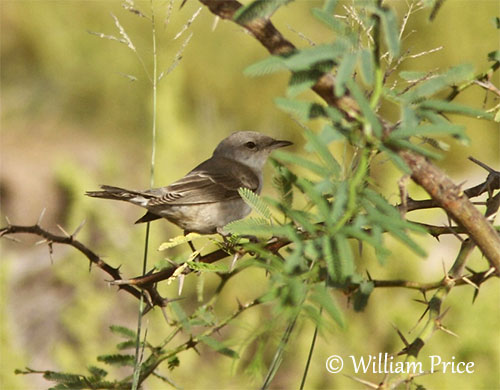
The Barred Warbler is strongly migratory. Migrations are nocturnal and the birds move solitary.
They leave the breeding grounds from July to September, the adults earlier than the juveniles. Arrivals in E Africa (Kenya) occur from late October/early November, with peak numbers in December/January.
They leave their wintering grounds from late March to early April. The spring migration takes place from mid-April to mid-May.
The Barred Warbler alternates several rapid wingbeats with short glides while flying.
The males perform aerial displays to attract females.
REPRODUCTION OF THIS SPECIES:
The laying takes place between May and July. This species produces a single brood per season.
The Barred Warbler has a complex mating system (see above “Behaviour in the wild”). Once the first attracted female starts to lay her eggs, the male attempts to pair with a second or third female in a new territory. The immatures may sometimes become helpers at nest.
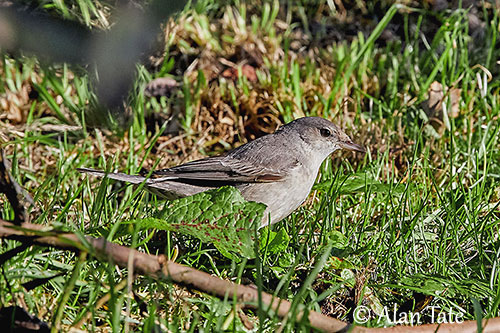
Although this species is territorial, several nests may sometimes be clustered in suitable habitats.
The male performs aerial displays accompanied by song. It also builds loose platforms, probably used as indication of male quality by females. These structures are rarely used for nesting, but the female may take some material to build the “true” nest.
Both adults build an open cup-shaped nest with spider webs and silk of caterpillar cocoons on the outer part of the structure. The nest is placed between 30 and 200 centimetres above the ground, within a dense, often thorny bush, well-hidden from view.
The female lays 3-6 pale greenish-grey, grey or whitish eggs with indistinct dark flecks, the latter fading rapidly. In monogamous pairs both adults incubate, and this period lasts 12-13 days, but the female does most of the work.
The nesting period lasts 10-11 days, but the young are cared for by both parents for up to 3 weeks after fledging. They may move over 1 kilometre from the nest.
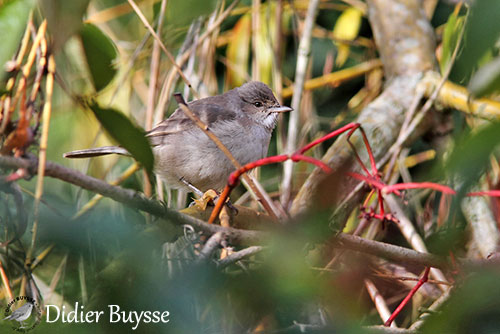
When the male is polygamous, the second female usually incubates and cares for the chicks alone, and the breeding success appears much lower.
The usual nest predators are Mustelids, red Squirrels, Corvidae and snakes. Parasitism of nests by the Common Cuckoo is common in some populations.
PROTECTION / THREATS / STATUS:
The Barred Warbler is described as locally common and widespread.
The species is affected by habitat loss in E Germany, caused by intensification of agriculture, ploughing of grassland and disappearance of large suitable areas. Fluctuations of both populations and range may also have climatic causes.
A very preliminary estimate of the global population size is 4,040,000/7,760,000 mature individuals. But more information is needed.
Marked annual fluctuations are noted locally, but the Barred Warbler is not globally threatened and the species is currently evaluated as Least Concern.
